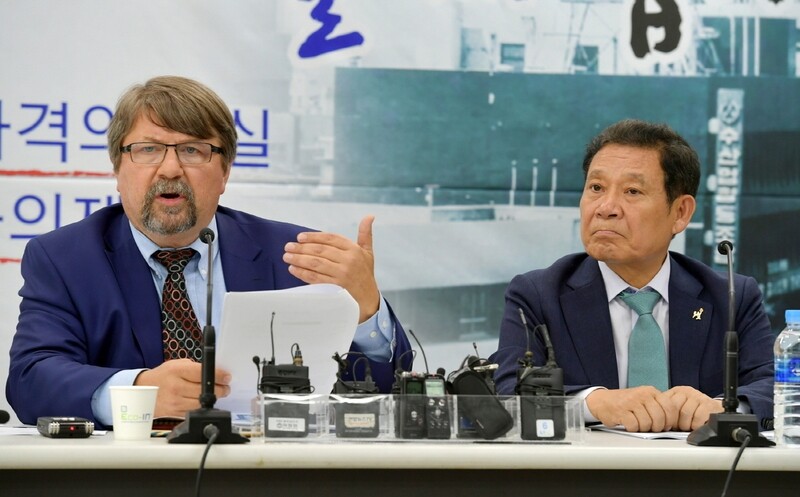hankyoreh
Links to other country sites 다른 나라 사이트 링크
US investigative piece exposes fallacy of NY Times article on N. Korean missile bases

“How ‘The New York Times’ Deceived the Public on North Korea.”
This was the title of an article published by US investigative journalist Tim Shorrock on Nov. 17 in the current affairs weekly The Nation’s online edition. Shorrock’s piece took dead aim at a New York Times report last week on suspicions of “secret missile development” by North Korea, claiming the newspaper relied entirely on data representing the US military-industrial complex’s views and building on them in an article including exaggerations and distortions.
On Nov. 14, the New York Times touched off the controversy when it cited a report by the US foreign affairs and national security think tank Center for Strategic and International Studies (CSIS) to claim that North Korea was conducting a ballistic missile development program at 16 “hidden bases,” which it said “suggest a great deception.”
“[New York Times reporter and article author David] Sanger, who over the years has been the recipient of dozens of leaks from US intelligence on North Korea’s weapons program and the US attempts to stop it, has come out with his own doozy of a story that raises serious questions about his style of deep-state journalism,” Shorrock wrote. The term “deep-state“ is used to refer to political messages produced deep within a "country’s core power structure.
Writing that the report “stretch[es] the findings” published by CSIS, Shorrock noted that the think tank “is deeply integrated with the military-industrial complex and plays an instrumental role in US media coverage on Korea” – suggesting that complex’s interests cannot be avoided in the institute’s reports on North Korea.
Shorrock also observed that while the report’s authors “added a huge caveat” in stating that some of its information “may eventually prove to be incomplete or incorrect,” the New York Times “ignored the warning and took the report several steps further.”
In his article, Sanger argued that because North Korea was lying about its missile program, it was not a trustworthy partner, and Trump himself had been deceived. In his response, Shorrock linked in his article’s text to an English-language translation of a Nov. 14 Hankyoreh article titled “NYT report on N. Korea’s ‘great deception’ riddled with holes and errors,” which discussed problems with the report.
In a Twitter message on Nov. 12, Shorrock wrote, “South Korea is quickly realizing that the US media is not their friend. The New York Times really should be ashamed.”
“David Sanger has been the US intelligence mouthpiece on North Korea for far too long,” he continued.
In 1996, Shorrock was the first to report on confidential US government documents concerning the May 1980 Gwangju Uprising. Last year, he further revealed that the US was aware of orders by the South Korean military regime’s to open fire on demonstrators during the 1980 uprising but allowed it to happen.
By Cho Il-joon, staff reporter
Please direct comments or questions to [english@hani.co.kr]

Editorial・opinion
![[Guest essay] The real reason Korea’s new right wants to dub Rhee a founding father [Guest essay] The real reason Korea’s new right wants to dub Rhee a founding father](https://flexible.img.hani.co.kr/flexible/normal/500/300/imgdb/original/2024/0423/8317138574257878.jpg) [Guest essay] The real reason Korea’s new right wants to dub Rhee a founding father
[Guest essay] The real reason Korea’s new right wants to dub Rhee a founding father![[Column] ‘Choson’: Is it time we start referring to N. Korea in its own terms? [Column] ‘Choson’: Is it time we start referring to N. Korea in its own terms?](https://flexible.img.hani.co.kr/flexible/normal/500/300/imgdb/original/2024/0423/3617138579390322.jpg) [Column] ‘Choson’: Is it time we start referring to N. Korea in its own terms?
[Column] ‘Choson’: Is it time we start referring to N. Korea in its own terms?- [Editorial] Japan’s rewriting of history with Korea has gone too far
- [Column] The president’s questionable capacity for dialogue
- [Column] Are chaebol firms just pizza pies for families to divvy up as they please?
- [Column] Has Korea, too, crossed the Rubicon on China?
- [Correspondent’s column] In Japan’s alliance with US, echoes of its past alliances with UK
- [Editorial] Does Yoon think the Korean public is wrong?
- [Editorial] As it bolsters its alliance with US, Japan must be accountable for past
- [Guest essay] Amending the Constitution is Yoon’s key to leaving office in public’s good graces
Most viewed articles
- 1[Column] ‘Choson’: Is it time we start referring to N. Korea in its own terms?
- 2Why Korea shouldn’t welcome Japan’s newly beefed up defense cooperation with US
- 3Senior doctors cut hours, prepare to resign as government refuses to scrap medical reform plan
- 4[Guest essay] The real reason Korea’s new right wants to dub Rhee a founding father
- 5[Column] The clock is ticking for Korea’s first lady
- 6Opposition calls Yoon’s chief of staff appointment a ‘slap in the face’
- 7Terry Anderson, AP reporter who informed world of massacre in Gwangju, dies at 76
- 8New AI-based translation tools make their way into everyday life in Korea
- 9Samsung barricades office as unionized workers strike for better conditions
- 10Korean government’s compromise plan for medical reform swiftly rejected by doctors